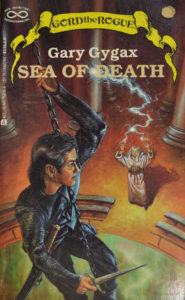James Raggi IV (designer of Lamentations of the Flame Princess) posted this on Google+ a few days ago (this is just the middle part):
I ask you: When did innovation and pissing off the establishment become something that smelly old farts did?
Seriously.
I think about the history of heavy metal, and how the groundbreaking acts, the ones who really pushed the boundaries of what noise could be made, and what do I find…
Venom members were just 19-21 years old when their first album came out.
Slayer were 18-22.
Possessed were 18-20.
Death members were 19 and 20.
Napalm Death, 18-22.
Carcass’ members were 18 and 19.
Sodom was 17-21.
Everyone in Entombed was a teenager, 17-19, when Left Hand Path came out.
Emperor members were 19-20 years old when their first record came out.
Mayhem, 18-19.
The Darkthrone guys were 18-19.
Hellhammer, 17-21.
Sepultura 16-18.
And figure the recording contracts were signed some time before, not to mention when the demos that got them signed would have been made. These fuckers were young. Making noise like no one before them because they wanted to be heavier, they wanted to be faster, they wanted to push things farther than they’d ever been pushed before. And the established music industry didn’t want to touch them, so their peers founded record labels just so this stuff could get out there and change the world. In many cases their mommies had to co-sign their record deals with them because they were minors.
And in gaming we’ve got… old, old fucks. The new noise is very often made by some crusty geriatric flexing his creative freedom after leaving his old company. Startup publishing companies are formed by people who have been gaming forever in order to release books by people who have been gaming forever because they too need to release their album of standards. Just like in metal, where the sickest shit today is made by the same people who were playing the sickest shit 25 years ago. It’s disgraceful.
Not quite as disgraceful as the kids getting together to ape their granddads. “Oh, how cute, these guys are 20 years old and playing just like Iron Maiden’s early stuff.” Timelinewise, that is just like Iron Maiden forming (in the 70s) and deciding instead of doing metal to base their sound on The Wizard of Oz’s musical numbers.
Who are the young rebels not obeying the laws of decorum and trying to piss off The Man with all our profanity? Well… me, Chandler, and Venger are all in our early forties. Alex “dicks dicks dicks” Mayo is even older. fuuuuuuuuuuuck. And our whippersnapper Kiel is 29. 29! Remember when you were young enough to think you could conquer the world? 29 is just a couple months away from being 30 and ANCIENT DEATH!
On the one hand, I totally agree that I’d like to see more young blood in the hobby.
On the other, Gary Gygax was 36 when he first published D&D, and Dave Arneson was 25. Mark Rein-Hagen published Vampire: The Masquerade when he was 27.
This has never been a hobby of teenagers publishing tabletop RPGs.
Moreover, if you want to see teenagers designing games, go to https://www.reddit.com/r/rpgdesign and check out the designs there. It’s not all 18-year-olds, of course, but it’s a pretty useful indication of what it looks like when teenagers design games.
I’m not being salty; I was like that at that age. Writing useful games is hard.
Now, I have no experience in writing music, but it seems to me that getting instruments together and composing a rock or punk song is something you can hack together. You don’t need a plan; you can be very lizard brained about it. The drummer lays down a beat, the bass player tries a few things, and the guitarists work out a chord progression. And as long as the four of you in the band know how to play it, once you’ve experimented enough to get a song, you’re done.
Tabletop RPGs have to be fixed in written language that your audience can grok. You have to use your left brain a lot when writing a game, while punk and rock are gloriously right brained. Sure, there’s some crossover, and there’s plenty of right brained work in making a game, but it seems to me there’s a lot more left brained work in making a game other people can understand how to play than there is in hashing out a 3-minute punk song.
Which leads us to an interesting question: How can we help 18-year-olds to write cool games?
If you’re a teenager reading this, here’s my advice:
- Read your favorite RPG specifically for how it explains its rules. If you want to make songs like Iron Maiden, you have to listen deeper, to how an Iron Maiden song is constructed of its various parts. Same thing here.
- In your game, be gloriously creative and imaginative when describing your world. Create a cool, weird environment for the game.
- When it comes to describing how players actually roll dice and interpret the results, be clear. Use your experience in the first point above. Change tone if you have to, so someone reading your game will totally understand what you’re saying.
- Find people outside of your friends to read and play your game. You’ll get a lot of bad feedback, but you’ll get some good suggestions, too, especially about what isn’t clear. If the feedback would change the fundamentals of your game, ignore it, but if it would help, definitely try it out.








